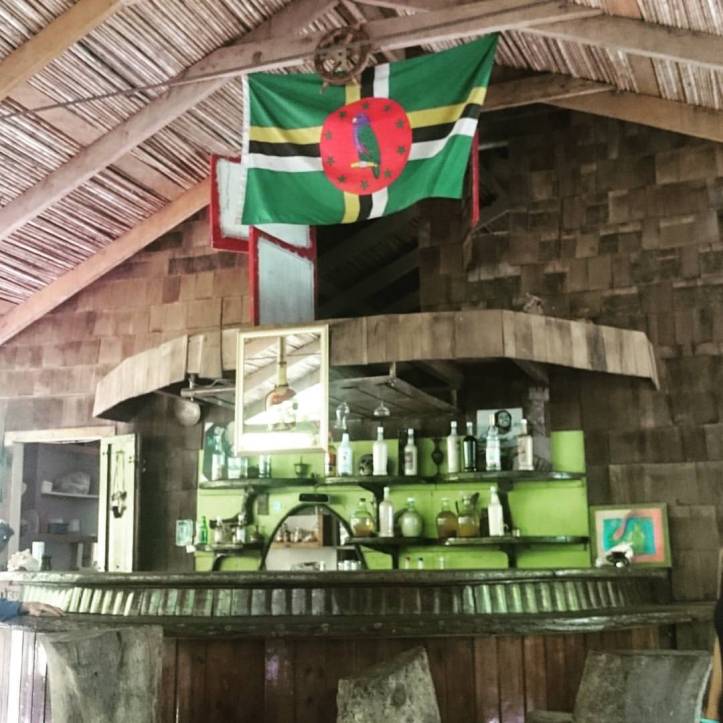
Contrary to popular opinion, there is actually serious hiking in the Caribbean Islands (and not just from the hotel to the beach) from the 10,000 foot scramble up Pico Duarte in the Dominican Republic, the highest point in the Caribbean, through the hovering, misty clouds of Nevis Peak, to the winding trails of ancient petroglyphs on the island of Saint John. But the crowning jewel of the Caribbean, by far, is the island of Dominica. Dominica is a hiker’s paradise; a mountainous, velvety green lump in the middle of the ocean, 29 by 16 miles small with gorgeous uncut rainforest and the last intact Carib Indian territory.
Dominica has never been your typical Caribbean island. When the first Europeans stepped ashore in the 15th century, they were confused because the native men spoke one language and the native women another. For the next few centuries, Dominica remained off the beaten track, a refuge to runaway slaves, too mountainous for the sprawling sugar cane plantations that came to dominate the rest of the West Indies. Today, Dominica is one of the smallest countries in the world, population 71,000, 15 degrees north of the equator and southeast of the much bigger Dominican Republic, which it often gets confused with. There are few beaches for tourists, no big hotels and no tiki-lighted limbo contests. But, there are over 70 active volcanoes on the island, 365 rivers (one for each day of the year) and plenty of rainfall. Every year Dominica gets a whopping 300 plus inches of rain, and our stay was no exception, as it poured down hard on Planet Waves while we were anchored in the beautiful harbor of Prince Rupert Bay, off the town of Portsmouth.
There is an upside to all this rain. As a result of the daily soaking, one is awarded with an unbelievable environment; an observable view from the cockpit of incredible fertility, with the hillsides carpeted in a million shades of green. Venture into the interior and one is met with grove after grove of fruit trees; oranges, grapefruits, lemons, limes, mangoes, six varieties of bananas, avocados, coconut, papayas, guavas, star fruit, bread fruit and passion fruit to name a few. Stunning green mountain peaks, some as high as 4,700 feet, make for a dazzling backdrop against a verdant skyline of blue. Christopher Columbus was asked to describe Dominica to the queen of Spain. He crumpled up a piece of paper and threw it on the table to show how mountainous and textured the island was!
Columbus would eventually learn why the native men and women spoke different tongues. The fierce Carib Indians, who had conquered all islands, exterminated the indigenous Arawak men but spared the Arawak women who continued to speak their own language. Today, everyone speaks English, often with a slight British accent (Dominica, a former British colony, gained independence in 1978) and the island is calm, with a growing economy based on eco-tourism and bananas.
We were able to complete three, albeit wet, hikes while in Dominica: the Indian River Source Trail, a portion of the Waitubuluki trail and the West Cabrits trail. We also took a small, guided boat trip up the Indian River, turning around after visiting the lush Jungle Bar, before the rain quashed our plans, making Dominica’s many trails too dangerously slippery for us to further our hiking goals. We will revisit Dominica in the dry season with plans to continue exploring.
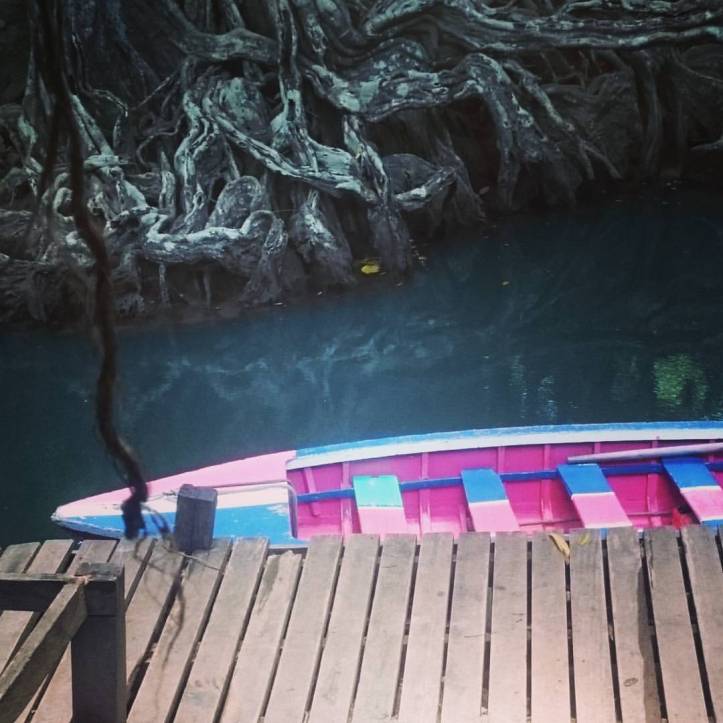
Along the Indian River and Water Source trail one can observe how the river quickly narrows and gets completely overhung in a canopy of huge, swamp, Bloodwood trees on both sides of the river’s banks. Their massive buttress roots spread out above the soil and down into the water, twisting and tangling into intricate, wavy illusion like designs. Overhead, long vines dangle into the river, fish appear below the water and crabs crawl along the rooted shoreline. Sounds of insects, animals and birds, the white heron and iguana among them, make for a magical, mystical quality in the atmosphere. The setting for the Witch of Calypso’s house, featured in the Pirates of the Caribbean 2, lies along the river’s trail where it is maintained for hikers to view.
Hiking along the first section of the Waitukubuli Trail, we swam off our heat in the cooling rapids of the Powell Basin pools after crossing a forested extension bridge that led directly uphill to an excellent view of Prince Rupert Bay, where Planet Waves lay at anchor. The Waitukubuli Trail is the National Trail of Dominica. It is the Caribbean’s first long distance trail and runs the entire length of the island from north to south. Reportedly, it takes 14 days to navigate the trail from beginning to end.
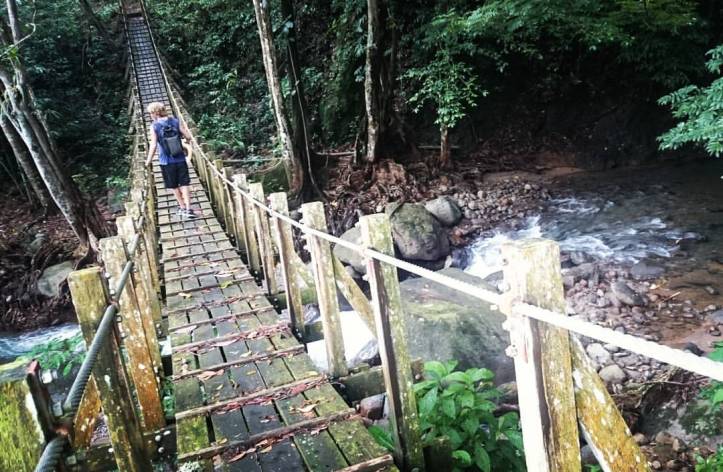
Hiking in the Cabrits National Park, the trails took us to Fort Shirley, an old British fort dating back to the 18th century, through the abandoned barracks overgrown with massive rooted trees and to the top of the West Cabrits peak, for an excellent view across the Caribbean sea of the islands of Les Saintes and Guadeloupe.
What is it like hiking amid nature’s abundant and splendorous mountain rainforests? Something that can be described along the lines of this:
The sun disappears above the canopy of trees and you find yourself in a cool, dimly lighted world. The vegetation is incredibly thick. The 125 feet tall Gommier or “Gummy” trees, with jungle vines dangling like tentacles, line the trail with spongy pillows of moss that you can put your fist through, huge, waxy elephant ears dominate the bush with dime size raindrops sliding off of them. Unlike most other jungles, there are no dangerous animals lying beneath the trees, no poisonous snakes, with the fiercest creature being the yellow land crab, one of which tried to pinch me as I stepped clumsily through a rocky stream. As you hike, if you choose, you could play Tarzan and swing from the vines to sail over mud puddles. We watched violet throated hummingbirds drink from lavender Morning Glories. We peeled cool, delicious Mangoes for snacks and cracked open fallen Coconuts for fresh milk to drink. The sounds in the forest are buffeted by crickets and frogs and the drumming of tropical rain. Near the trails are running rivers, waterfalls and balmy, tranquil but rapid waters that can seep into your skin as you soak for a much needed rest.
Sometimes the trails in Dominica are perfectly marked and well cleared and sometimes they are not. The trekking could at times get tough and induce shortened wind and panting. There are two types of hiking in the world: heads up or heads down. Heads up means the conditions are good, the trail is smooth, and you can scan the tree tops for birds and gaze off into the misty distance. Heads down means you ain’t looking at nothing except your own two feet in front of you and where to put them next! Having a hiker’s staff can help.
We wish to do much more on the island when we head north. Dominica boasts a variety of nature including the 365 rivers I mentioned earlier, streams, waterfalls, hot sulphur springs, a boiling lake and four cold freshwater lakes more than 2500 feet above sea level. The island is home to two species of parrots, both endangered, and found nowhere else in the world. The Imperial, known locally as the Sisserou, is Dominica’s national bird. The red-necked or Jaco Parrot is smaller and can be found at lower elevations than the Imperial. Hiking enthusiasts claim the Boiling Lake Trail is the definitive, most challenging, best hiking trail in the Caribbean. Dominica’s Morne Trois Piton National Park is the only UNESCO World Heritage Site in the Eastern Caribbean.
The island of Dominica is a floral paradise. There are over 1,000 species of flowering plants, including 74 species of orchid and 200 species of fern, with the national flower being the bwa kwaib. In the interior west coast there is an abundance of dazzling flowers, including the orange, pink and yellow Lantana and the bottle brush flowers of the Campech, red, yellow and green Heliconias and the purple leaves of the blue Wax flower.
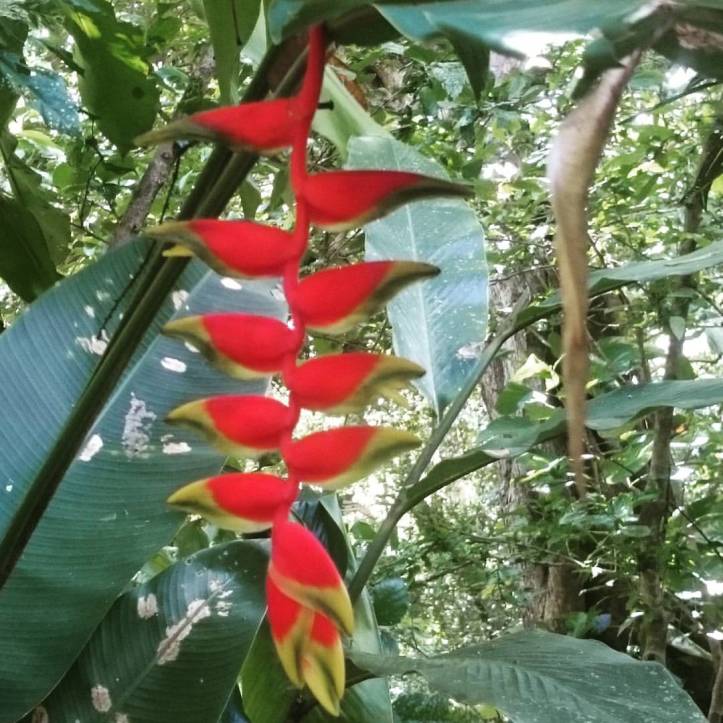
Twenty one years ago, Dominica was a favorite stop for us, but very different then than now. In the capital town of Rouseau, we met a lot of local men and women who we found engaging and fun and listened seriously to their frustrations about their lack of opportunities for work. Educated and skillfully trained, they were torn about the prospects of having to leave their island country in order to pursue a living in their respective fields. Then, we were required to anchor in deep water off Rouseau, and bring our stern along to the bank where it was tied off to a tree on the shore line. A group of men had fought for the job of tying our lines for a paltry amount of money and we had felt constant pressure from them to purchase their so called services during our stay. While anchored in Prince Rupert Bay, we had been hassled by the “boat boys” who clung to our lifelines and pestered the living daylights out of us to buy things from them or give them money. I have video of a bewildered looking young man on a surfboard holding on to our lifelines with a strange look on his face while we stacked to the back of his surfboard all of our unwanted canned food we had purchased in Trinidad. In shocked, unguarded amazement, he looks into the camera and says, “But…you have something to give?”
Today, Dominica appears more economically robust in general, and with the government’s help, has put into place a structural organization for the implementation of services to the yachting and eco tourist community consumers. The “boat boys” of yesterday are long gone and replaced by a group of gentlemen called P.A.Y.S. (Portsmouth Association of Yacht Services) which are comprised of trained certified guides and local businesses that patrol Prince Rupert Bay and for a regulated fee, help boaters with numerous services, from taking garbage, to organizing scuba trips, to interior driving tours, to guided hikes of all types, to mooring assistance and much more. If you want to snorkel or dive in the marine parks, you must hire a guide and purchase a park pass. There is plenty to do independently, but services are made to offer for a reasonable price, by gentlemen who are courteous, friendly, and very knowledgeable about the island. Every Sunday the PAYS members hold a fundraising BBQ on the beach, all you can eat chicken and pork with all you can drink rum punch. It is well attended and the food and music are fantastic! In the city of Rouseau, rather than having to anchor in deep water, mooring balls are now provided at a reasonable price. With the mooring fee comes the security of having the waters patrolled through the night and a safe place to land your dinghy. In the downtown capital, we found a lot of activity, a booming medical school, a thriving shopping district and several construction projections. Work opportunities seemed improved to us. We spoke with a young man who could recall playing along the waterfront as a young child some twenty years ago, during the time when we were anchored and tied to the tree, and appeared to be genuinely delighted to learn that having been in his country once, we had made a determined and enthusiastic point to return.
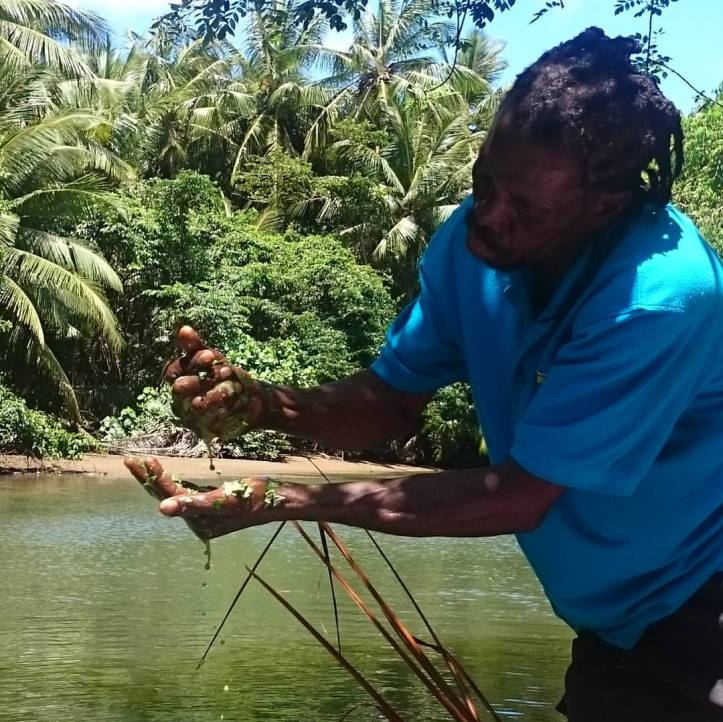
Did I mention how beautiful the people are? Every person we encountered we found to be friendly and exhibiting a natural curiosity about us, our sailing travels and our home and family back in the U.S. We were invited into homes, given fruits and vegetables from gardens, encouraged to share in homemade spirits from passed along family recipes, smiled at, waved to, and laughed with. In sum, an extraordinary experience!
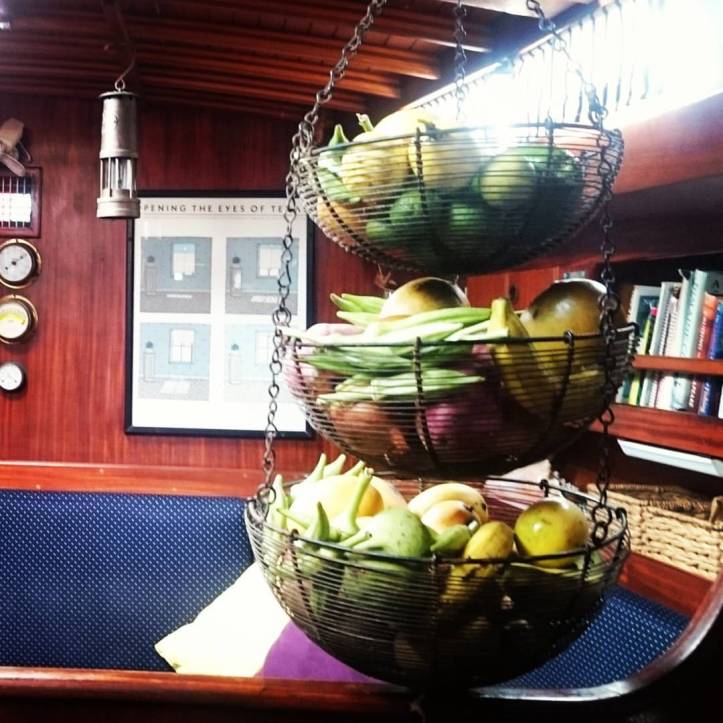
Thank you for reading my blog. I have a ton of pictures of Dominica so hope you will follow my Instagram account @shelleysdavis.
Well you are seriously hiking along. We are in Martinique. We have mixed up your email address.
Regards
Ken & Christine
Sv Code Zero
LikeLike
Hey guys! We are presently in Falmouth Harbor, Antigua doing some much needed wood work. Good to hear from you. We think of you often. Our email address is planetwaves@msn.com. We bought new battery in Martinique. Merry Christmas and we hope to see you both in the coming new year.
LikeLike